As the new season is now underway I thought I would run through some of the key items of tackle I will be using over the coming months and the reasons for my preferences. I hope this will be of help, especially to those who are just starting out on their own barbel fishing journey. It also means that as the season unfolds I can concentrate more on the stories behind the fishing as the tackle will always be much the same.
Off and on my personal journey has lasted for fifty years, and the anticipation as a new season dawns is every bit as heightened as it was back in the days when England were actually winning the football World Cup.This season will not be quite the same though; I’m going to miss the phone calls to my old mate, nothing ever stays the same.
So let’s talk tackle and we’ll start with the obvious:
Rods
I am very fortunate, I’ve had an association with Free Spirit for a very long time and as far as I’m concerned their rods are as good as it gets. Over a season I see many different barbel rods, every angler who comes out with me has their personal favourite, but I’ve yet to see one rod that would make me change from the ones I use. Plus, I don’t think I’ve had one angler who has not enjoyed using my rods and I know from feedback that quite a few have been so impressed they have gone out and bought one for themselves.
On small rivers like the Kennet the 11ft Seeker is perfect for most swims but I will use the 12ft version if needed. On wider rivers such as the Severn and Wye the 12ft Big River Specialist works a treat and those rods will cover the bulk of the situations I’m faced with.
I’ve mentioned a dedicated baitdropper rod many times before, I tend to use two. A bog standard 1.5lb test curve does the job for the narrow rivers and small droppers while a heavier carp style rod up to 3lb test works well for the bigger droppers on the wider rivers. These rods I buy very cheaply along with a basic reel and I look to get a couple of seasons out of them.
Reels
When it comes to reels, ninety nine percent of the time I use a centrepin, I have done for many years and I just enjoy using them. I’m not going to say they are the best for all occasions but I will say they are best for me. I’m not a ‘pin connoisseur, to me they are tools to do a job and as long as the noise they makes appeals to my failing sense of hearing then that’s good enough for me!
I have Rapidex models which I really do like, Speedias, Trudex, Match Aerial replicas but the one that is now my reel of choice is a battered old Aerial. A rather special reel in that it belonged to Fred Crouch, if just a tiny piece of his magic comes my way then I’ll be a contented barbel man.
I do use a fixed spool on the odd occasion and when I do it’s a small Baitrunner, I don’t use the large ones as for me they are just too clumsy and bulky! I like to fish for barbel with finesse, that’s me!

Landing Net
My landing net of choice is a 36 inch Free Spirit S, I like the two piece handle which reaches as far out as I need and the mesh is nice and deep to rest the fish, it’s expensive for sure but it will last a lifetime and is pure quality.
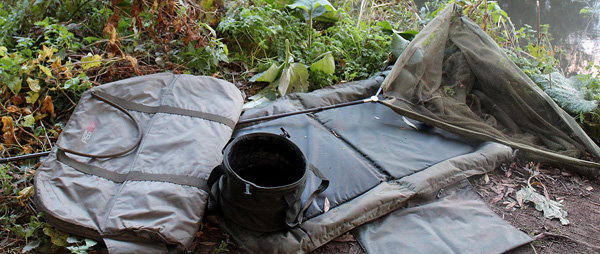
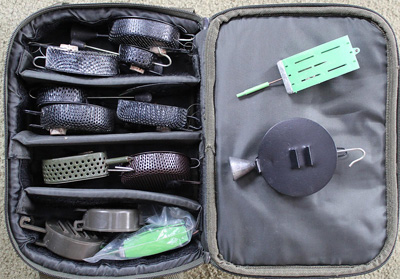 There’s not really enough time or space to go into real detail about the terminal tackle and other bits and pieces save to say I never look to complicate matters. That said there are a few items that deserve special mention.
There’s not really enough time or space to go into real detail about the terminal tackle and other bits and pieces save to say I never look to complicate matters. That said there are a few items that deserve special mention.
Baitdroppers
I have many and like to use models with short stems. I have written a very detailed feature on this subject on my website; you can read it HERE
Feeders
I tend to use the Drennan flatbed for maggots, the Kamasan Black Cap for casters and Fisky’s feeders for pellet and groundbait.
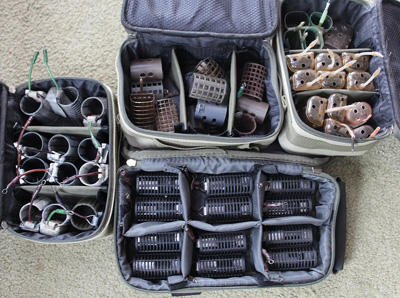 PVA Bag Clip Swivels
PVA Bag Clip Swivels
These are brilliant. It’s always best to have the bag near the lead rather than on the hook because you know the feed won’t travel too far past your hookbait. You can take the hook back into the mesh which is very helpful when fishing in streamer weed.
Micro Swivels
I use these because it means I can tie up shortish hook lengths of varying material, forming a combi-type rig. I find they work better than trying to tie an Albright knot which can be tricky at times. I use these in conjunction with:
Enterprise Adjuster Stops
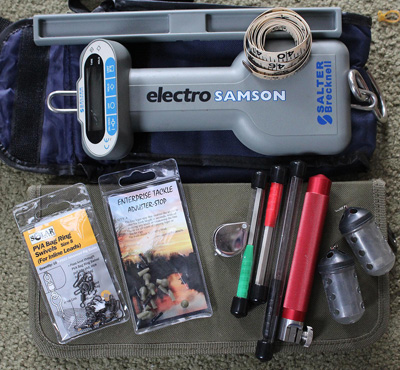 These leger stops are excellent and I incorporate them whenever I know that I will be adjusting the hook length through a session. Old fashioned and I’m amazed at how often people are surprised at the versatility these tiny items afford you.
These leger stops are excellent and I incorporate them whenever I know that I will be adjusting the hook length through a session. Old fashioned and I’m amazed at how often people are surprised at the versatility these tiny items afford you.
I’ll end this part of the diary now but will revisit and go through other tackle items in more detail over the coming months but now I’ll answer more of the very interesting questions posed by FishingMagic readers.
Do you regret the fact that, on many rivers at least, barbel fishing has simply become the same as carp fishing – same baits, methods etc.
I wouldn’t use the word ‘regret’ because I am sure the carp industry has had a positive impact on barbel fishing, particularly on the tackle front. Carp fishing as a heading is perceived in many different ways and this I suppose is what the question really refers to.
At one end of the scale stalking a carp on the surface with just one rod and requiring great stealth is very similar to the barbel angler roving the river searching out the swims, the intimacy is the same. But long stay, bivvies, heavy baiting, four rods, sleeping bags etc – that’s as far removed from barbel fishing as it’s possible to get!
A big subject this one and so easy to put across the wrong kind of sentiments. If I had to fish two rods on buzzers pointing to the sky on a patented scaffolding I wouldn’t go barbel fishing – simple as that – and just my personal choice, I’m not knocking it, I just wouldn’t enjoy it.
Carp anglers have been the real innovators during my lifetime and barbel anglers have simply benefitted from that, both in terms of methods, baits and the tackle that has been produced. I don’t like to see carp style tactics on small rivers, it just doesn’t look or seem right to me, that form of barbel fishing is about intimacy and being at one, and the carp style does not give that, not to me anyway! On the bigger rivers it’s not so bad but then again I would always seek out places to fish close in and in a style that I like.
So I suppose it’s inevitable that the carp style has made big inroads into barbel fishing, all I would say is treat that style as just another string to your bow, don’t make it the be all and end all because you’ll be missing out.
How far downstream do you reckon barbel can scent your hookbait – and do flavourings really make any difference?
I realise that some will disagree but as far as I’m concerned not that far and only to your confidence – let me expand.
I must have spent hours and hours discussing this topic with Fred Crouch and while I am not quite so adamant in my beliefs I do not believe that barbel have evolved to the extent that they have an acute sense of ‘smell’ or a palate that befits a Masterchef contestant! Barbel eke a living foraging around on the river bed grabbing a grub here and an insect there, if they had super senses they would surely do better than that!
Some barbel anglers talk about putting down a scent trail, I prefer to lay a food trail, by that I mean leading the fish to the table by way of laying a trail of hemp. Bait is a major part of fishing and many anglers enjoy making, inventing, and preparing their own baits, always looking for that Holy Grail which if we’re honest no one really wants to find. I’m not one of those, just haven’t the time or inclination but good luck to the many that do.
My guess would be that a barbel’s senses work in tandem and the fish would therefore have to be reasonably close to the bait before it recognised it as such. If you pushed me for a distance I would suggest in the region of ten feet.
Flavourings are all part of the fun, they make a difference if you believe they do and lots believe! I’ve played around with different flavourings, dips and glugs, they work but no better or worse than plain old meat.
You used to read a lot about deformities in barbel – extra barbules and such – does this still happen only you don’t hear much about it these days.
The deformities such as twisted backs most certainly do still occur and the extra barbels may still be there, perhaps we don’t look so closely these days. I am sure the deformities are genetic and it would seem that even the most severe back issues do not prevent the barbel living out an existence. There are one or two big fish I see on the 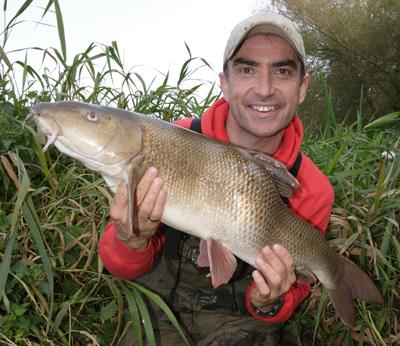 Kennet with a back deformity and they appear to be healthy enough. I’ve seen fish on the Severn and Royalty that are practically bent double and they still pick up bait but certainly fight in a strange manner!
Kennet with a back deformity and they appear to be healthy enough. I’ve seen fish on the Severn and Royalty that are practically bent double and they still pick up bait but certainly fight in a strange manner!
Many barbel are blind, not always obvious but once again they are able to live out their lives.
The extra barbels – I prefer barbel to barbule – are still around on some fish and I always took a view that it was regeneration when damage to a nerve occurred, perhaps by an oversized hook? We all know how sensitive this part of a barbel’s anatomy is. I used to talk to Fred Crouch about this and he came around to the same idea. Pure guesswork but I haven’t read anything that has given the definitive reason for the phenomenon.
Otters wiped out the huge Ouse barbel and are making serious inroads into the Kennet and other rivers, certainly the Oxford ones. Is the future of the species in danger?
I certainly hope not and I don’t believe it is.
I’ve said many times that I’m an eternal optimist, some have said I have my head buried in the sand but I don’t think that’s true. Judging by the pictures I’ve seen posted on Facebook since the season began it hardly looks like barbel fishing is in terminal decline.
Otters are here to stay, we just have to live through what I believe is a transition period and accept that things won’t be the same again, they will be different. I’m not so sure about rivers like the Kennet, some places have, and are suffering, but otters have been established on the stretch I fish for a good few years and the barbel are still there to be caught.
Notwithstanding the last two paragraphs I take a view that in the short term our smaller rivers will suffer but the larger rivers will cope. We have a tendency to compare the current situation with the peak time instead of looking at the ‘mean’, it’s worth remembering that Len Head in his excellent book, River Fishing – published just thirty year ago – was saying, ‘It is unfortunate that barbel are found in only a few British rivers.’
Anglers are notorious for their selective memories!
Our best hope to expose the reality of otters on our small rivers is to show the damage they do to bird and wild life. That way public perception will change, the big powerful organisations will become involved and angling would then join the fray. On our own we will get nowhere.
I’ve been told you don’t have to actually cook hemp for it to work for barbel, just soak it – is that right? Isn’t it dangerous not to cook particles?
Well since I wrecked my Burco Boiler and now that I mostly use the Dynamite Frenzied hemp I tend not to ‘cook’ it.
The loose hemp I use is prepared as follows. I half fill a cool box with the hemp then top up the box with cold water making sure there is an inch or two of water above the hemp. After thirty six hours I strain off the cold water, and top up once again with boiling water. After another twelve hours the hemp is ready. Most of the seeds will have split and I mix this with the Frenzied Hemp in equal measure.
Hemp passes straight through a barbel, if you doubt that then next time you catch one that has been feeding over your hemp gently rub the belly towards the vent and you will catch a handful of hemp that would appear to be the same as what’s in your bucket!
Fred Crouch never boiled hemp; he would just soak it in cold water overnight to ensure it had the weight to sink. He didn’t believe barbel swam around the bottom looking for bits with the white shoot sticking out! He also believed barbel used it to grind down the soft tissues they may be eating. I’m not entirely sure I agreed with that notion as I think there is more to it than that and likewise I prefer to see the bulk of my hemp having the white shoots exposed!
On the danger aspect it’s well documented about how particles need to be prepared, I take a view that hemp is perfectly safe to prepare in the manner I have described.
That’s it for now and all the questions have been answered, I hope there are more for the next close season. In the meantime I have a very busy time in front of me, lots of fishing to do, lots of stories to tell and hopefully lots of fish on the end of my line!
Enjoy the summer, see you soon.










